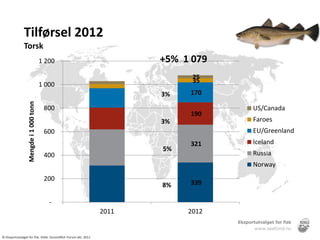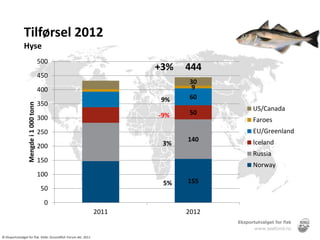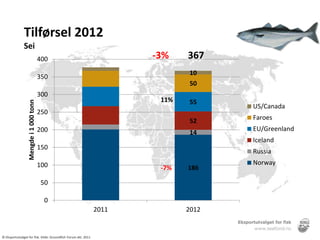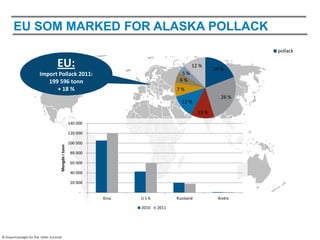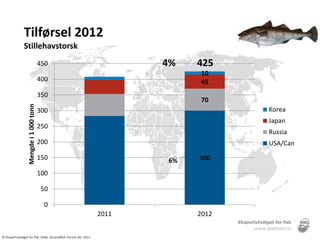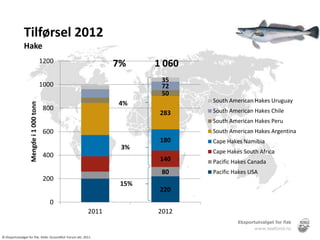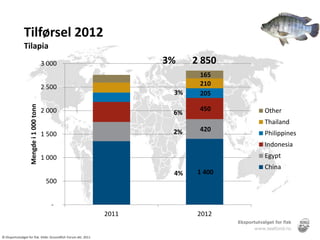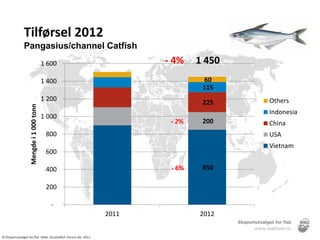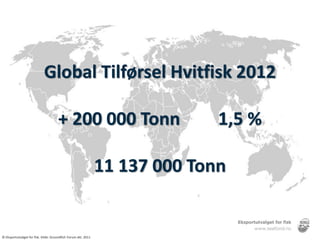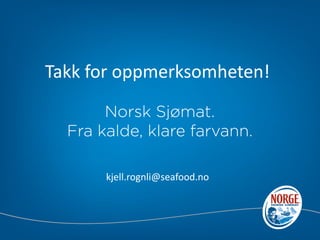Torskefiskkonferansen 2011 - Kjell-Ă ge Rognli
- 1. Global tilførsel hvitfisk 2012 Kjell-à ge Rognli Markedsanalytiker
- 2. Global tilførsel hvitfisk 2012 Utviklingstrekk EU
- 3. Tilførsel 2012 Torsk 1 200 +5% 1 079 25 35 1 000 3% 170 Mengde i 1 000 tonn 800 US/Canada 190 3% Faroes 600 EU/Greenland 321 Iceland 5% 400 Russia Norway 200 8% 339 - 2011 2012 Š Eksportutvalget for fisk. Kilde: Groundfish Forum okt. 2011
- 4. EU SOM MARKED FOR TORSK torsk pollack EU: 12 % hake 5% 26 % Import torsk 2011: pangasius 6% 269 343 tonn 7% annen hvitfisk + 8,5 % hyse 12 % 19 % sei 13 % Andre 100 000 90 000 80 000 70 000 Mengde i tonn 60 000 50 000 40 000 30 000 20 000 10 000 - Norge Island Kina Russland USA Andre 2010 2011 Š Eksportutvalget for fisk. Kilde: Eurostat
- 5. Tilførsel 2012 Hyse 500 +3% 444 450 30 400 9 9% 60 350 Mengde i 1 000 tonn US/Canada -9% 50 300 Faroes 250 EU/Greenland 140 Iceland 200 3% Russia 150 Norway 100 5% 155 50 0 2011 2012 Š Eksportutvalget for fisk. Kilde: Groundfish Forum okt. 2011
- 6. Tilførsel 2012 Sei 400 -3% 367 10 350 50 300 11% 55 Mengde i 1 000 tonn US/Canada 250 52 Faroes 200 EU/Greenland 14 Iceland 150 Russia 100 Norway -7% 186 50 0 2011 2012 Š Eksportutvalget for fisk. Kilde: Groundfish Forum okt. 2011
- 7. Tilførsel 2012 Alaska Pollack 3 500 1% 2 995 3 000 50 6% 220 2 500 Mengde i 1 000 tonn S-Korea 2 000 1 400 Japan Russia 1 500 USA 1 000 2% 1 325 500 - 2011 2012 Š Eksportutvalget for fisk. Kilde: Groundfish Forum okt. 2011
- 8. EU SOM MARKED FOR ALASKA POLLACK pollack EU: 12 % 19 % torsk hake Import Pollack 2011: 5% 6% pangasius 199 596 tonn + 18 % 7% annen hvitfisk 26 % hyse 12 % sei 13 % Andre 140 000 120 000 100 000 Mengde i tonn 80 000 60 000 40 000 20 000 - Kina USA Russland Andre 2010 2011 Š Eksportutvalget for fisk. Kilde: Eurostat
- 9. Tilførsel 2012 Stillehavstorsk 450 4% 425 10 400 45 350 70 Mengde i 1 000 tonn 300 Korea Japan 250 Russia 200 USA/Can 150 6% 300 100 50 0 2011 2012 Š Eksportutvalget for fisk. Kilde: Groundfish Forum okt. 2011
- 10. Tilførsel 2012 Hake 1200 7% 1 060 35 1000 72 50 4% South American Hakes Uruguay Mengde i 1 000 tonn 800 South American Hakes Chile 283 South American Hakes Peru 600 South American Hakes Argentina 180 Cape Hakes Namibia 3% Cape Hakes South Africa 400 140 Pacific Hakes Canada 80 Pacific Hakes USA 200 15% 220 0 2011 2012 Š Eksportutvalget for fisk. Kilde: Groundfish Forum okt. 2011
- 11. Tilførsel 2012 Tilapia 3 000 3% 2 850 165 2 500 210 3% 205 Mengde i 1 000 tonn 2 000 450 Other 6% Thailand 2% 420 1 500 Philippines Indonesia 1 000 Egypt China 4% 1 400 500 - 2011 2012 Š Eksportutvalget for fisk. Kilde: Groundfish Forum okt. 2011
- 12. Tilførsel 2012 Pangasius/channel Catfish 1 600 - 4% 1 450 1 400 60 115 1 200 Others 225 Mengde i 1 000 tonn Indonesia 1 000 - 2% 200 China 800 USA Vietnam 600 400 - 6% 850 200 - 2011 2012 Š Eksportutvalget for fisk. Kilde: Groundfish Forum okt. 2011
- 13. Global Tilførsel Hvitfisk 2012 + 200 000 Tonn 1,5 % 11 137 000 Tonn Š Eksportutvalget for fisk. Kilde: Groundfish Forum okt. 2011
- 14. Takk for oppmerksomheten! kjell.rognli@seafood.no



